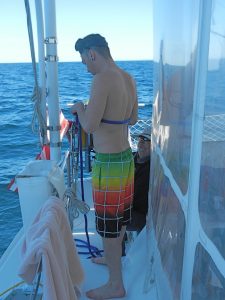Friday, 9 March 2018
I wake up as the sun rises over Neah Bay. In the enclosed cockpit a little towhee has found shelter. Maybe a good omen for the day to come? Sailors are a suspicious lot. It must have slipped through a crack in the canvas. By the time I get things ready for a stick-to-your-ribs breakfast of porridge with blueberries for the crew, the bird has escaped.
We’re taking another run at it. After fuelling up we leave the fishing and lumber village, retracing our route around Cape Flattery and into the Pacific. What a contrast to yesterday. The sky has cleared and we see cargo ships entering the Strait of Juan de Fuca on their way to ports in the Salish Sea. The shores of Vancouver Island and Washington stand out is clear detail, and from our vantage point the Cape Flattery lighthouse situated on a treed islet looks like a church spire bidding us godspeed.
We have a slight westerly breeze not enough to move us along at more than a snail’s pace. The captain is eager to reach San Francisco within the week, and so we keep the engine running. After a few hours the wind shifts to the southwest and we douse the flapping sails.
I have experienced a night sky in the country far from city lights and above the arctic circle but tonight it is as grand as I have ever seen. Maybe I notice it so much because I am lying in my cabin looking straight up through a glass hatch above my bed.
Saturday, 10 March 2018
Everything runs smoothly on my 2-6 am night watch until I run over some crab pot line. The port (left) engine shudders and I have to “kill” it in a hurry. Did the captain and crew ever come jumping out of their berths in a hurry! The rest of the night we’re running on the starboard engine. Later in the morning the wind freshens from the south-easterly direction. So up with the sails and off with the motor, hurray! This lasts for a few hours until the wind lessens and veers to come right on our nose.
The sky is as clear today as in the night, with the daylight temperature hovering around 16˚C. Twenty nautical miles off the south Washington coast near the mouth of the Columbia River we stop and my crew mate, Bo, dons swim trunks, diving mask and a rope around his waist, jumps into the frigid sea and, after only two attempts, frees the propeller from the crab line. He’s our hero and surely deserves the hot shower we don’t often allow ourselves to take because on board one needs to conserve precious water.
Photo: Bo is getting ready to dive.

